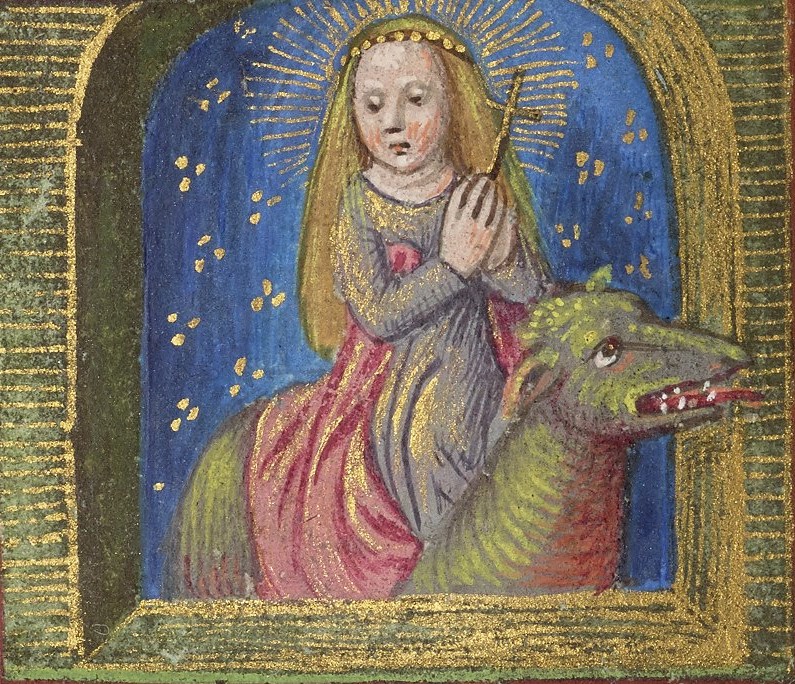Symbolism around the Virgin and indeed Christ in medieval images is often multi-layered, as we have seen in the previous post; colours, animals, flowers all have their place in this sometimes very intricate communication. Perhaps the most straightforward depictions are those of the Christian saints, the early martyrs of the church who became forever associated with the recognisable features of their torture, miracles and deaths. As an example, many of us will be familiar with St Catherine and her wheel and understand that it played some part in her martyrdom.
This conversance is partly due to the success of another text of the 13th century: the Golden Legend, a collection of hagiographies (biographies of saints and their miracles) by Jacobus de Varagine that was widely read in late medieval Europe.

This image from Latin MS 164 shows St Catherine about to be beheaded. It is a common misconception that she was martyred on the wheel, which according to the legend she miraculously breaks. This is clearly depicted in the image above.
However, not all presentations were so straightforward and sometimes a greater subtlety has been employed by the illustrator which makes us have to work a little harder to figure out the reference. The three images below are all of St Margaret. St Margaret of Antioch was tortured and imprisoned for her conversion to Christianity. She was tormented by the devil in the form of a dragon who swallowed her whole, but he was forced to expel her because of the cross that she still carried. This is shown in two of the images; the third chooses to show a far less common element of the legend, which is that Margaret was reputedly tortured with fire that miraculously did not scorch her skin.



From L-R, St Margaret in Rylands Latin 39, Rylands Latin 21, Rylands Latin 164.
The saints were the ultimate Christian role-models, aspirational in their faith and endurance, often achieving cult followings for their reported ability to intercede with God on particular matters, especially health. The popularity of saints sometimes increased and waned depending on the circumstances. St Margaret became associated with childbirth as she was essentially safely re-born from the dragon that swallowed her. This veneration of saints and retelling and re-showing of their physical piety also symbolised to the viewer that there was a link between ‘spiritual morality and earthly health’ and gave the ‘ever present possibility of a miraculous cure’ to their afflictions. (1).
Of course, one of greatest health threats to Europe in the later medieval period was the plague. It first reached the west in 1348 and killed almost half the population within a matter of months, continuing to break out periodically for centuries after (2). Characterised by discoloured swellings that sometimes developed into open wounds, some saints were identified as plague saints, able to intercede for recovery or to protect against the threat of sickness. One such example is St Sebastian whose punctured, bleeding body, shot repeatedly with arrows (from which he did not die – he miraculously revived and was later beaten to death) was a close visual reference for the marks of the disease and gave hope to those praying to him to aid recovery.

St Sebastian, Rylands Latin MS 38.
Next – Medieval Storytelling: Beyond the Borders
- Jack Hartnell, Medieval Bodies, Life Death and Art in the Middle Ages, Profile Book & The Wellcome Collection, London, 2019. P.23.
- Erika Langmuir, A Closer Look at Saints, National gallery, London, 2009, p.87.


0 comments on “Medieval Storytelling: From Golden Pages to the Golden Legend”